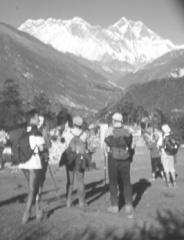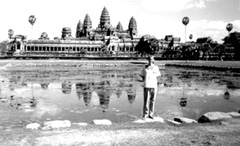
This guide is meant for the predeparture and planning stages of a budget-backpacking trip to Southeast Asia. Much of it can actually be applied to a trip anywhere in the third world. Comparisons with other regions such as West Africa, Mexico and the Indian Subcontinent (South Asia) are meant to shed some light on the relative circumstances of Southeast Asian travel. So, if you haven't left yet, hopefully you'll find some of these insights to be useful in sorting through the countless questions and options you've undoubtedly encountered. If you're currently on the road, maybe this guide can help you increase your appreciation for and enjoyment of the trip you've undertaken. If you've just returned, then you can tell whether or not I'm full of it, and use my ideas here to give you a more well rounded basis for giving advice to others.
This is not a mainstream budget travel guidebook. My purpose here is to provide a small, pocket-sized, inexpensive yet comprehensive guide to extremely cheap budget travel ideology. Everything you need to know to execute your trip successfully is enclosed. This is especially intended for those of you who want to maximize your foreign experience by not only getting off the beaten track, but by getting out of your foreigner mindset as well. For example, if you want to go to Bangladesh to live as a Bangladeshi lives, then this is for you. If you just want to see sights and learn about Bangladesh remotely through the window of a tour bus, then this is not for you. My purpose here is to show you how to infiltrate the local culture, so that you act like and are treated as a local, even if you donít quite look like one.

It can be tough to get away from the spandex crowd (Nepal).
Essentially, if you're serious about taking an all out, cheap as heck, live-like-the-locals type of budget trip, you'll find the other guidebooks to be not only useless, but counterproductive as well. They fog your mind by limiting your horizons. They make you too dependent on whatís inside their covers, rather than letting you focus more on the country at hand. For example, I see too many travelers lost with their eyes glued to their guidebook map rather than asking a friendly passerby for directions. There is an inherent mistrust of others which needs to be overcome. By the time these people realize they're not getting out of their trip what they had hoped for, more often than not it's too late, and almost time to go home. While the trip may still have been enjoyable from a curiosity standpoint, people tend to say that "next time" things will be different. Sadly, there won't often be a second chance.
I'm only referring to travel philosophy and planning here. This is not a substitute for a sightseeing guide. There are, in fact, numerous guidebooks that do an excellent job as an introduction to the historical and cultural tidbits of what you pass through. By all means, take one of these books with you, as they too will greatly enhance your appreciation for your trip (see 5. what to bring).
A large problem is that there are many misconceptions about travel in the third world. Many of these misconceptions are fueled by the very travelers that have just returned from their "life changing" adventures. In an effort to make up for what they didn't find themselves, they fabricate tall tales of danger, romance and heroism. To the friends and family back home with no concept of what lays beyond, it makes perfect sense. But donít take their word for it. Iíve heard a lot of travel tales in my time, and most of them are stretched, all in the name of making a good story, of course. Keep in mind that dissatisfaction often still lingers rather vaguely. This whole process is part of human nature, our innate desire to not come back empty handed, having wasted our time.
One of my goals here is to set the record straight. It's not dangerous, it's not filthy, communication is not necessarily difficult, it's not swarming with mosquitoes (ever been to the Sierras in July?), the food is edible, the water is fine, and so on. Take all of your preconceptions of what lays beyond the great blue waters and toss them aside. You need to go into your trip with a positive, open mind, expecting nothing but the best. For the most part, life is good and enjoyable for the budget traveler. Donít worry. The scariest place you're likely to come across is the Khao San Road in Bangkok, insertion point for many budget travelers into Southeast Asia, where freaks from all over the Western world soak up their Asian experience over a cold beer, with joint in hand, while watching Mike Tyson on big screen TV.
Before you sort out much, take some moments to ponder why you're taking this trip, and where you hope to be in your life when you get back. What do you hope to accomplish? Are you interested in Asian language, culture or history? Do you want to visit "exotic" places? Do you want to get away from it all? Do you have a job or school to return to? Do you want to revel in the supposed lawlessness, indulging in ubiquitous and cheap dope, opium and girls? Why are you going? You donít need answers to any of these now, but thinking about them may motivate you for the trip. Like you, I want you to fulfill your goals, and this guide will help you get there. I want you to come back knowing you did what you now want to do.
Before you move on, you need to understand the greatest key to long term, adventurous, independent travel. Believe me now: nothing is going to happen if you follow the book (this one included). It's the old story, you can lead a horse to water, but you cannot force him to drink. Above all, hopefully you'll realize that you need to do your own thing.

This could be you (Angkor Wat, Cambodia).